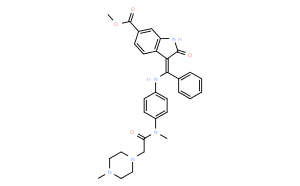| SKOV3 |
Function Assay |
5 µM |
24 h |
DMSO |
induces a significant increase in the promoter activities of E-cad, CDH1, and CDH3 |
26061747 |
| A549 |
Function Assay |
2/5 μM |
24 h |
DMSO |
has a general EMT reversal effect |
26061747 |
| T24 |
Function Assay |
2/5 μM |
24 h |
DMSO |
has a general EMT reversal effect |
26061747 |
| Mia-Paca2 |
Function Assay |
2/5 μM |
24 h |
DMSO |
has a general EMT reversal effect |
26061747 |
| A549 |
Function Assay |
0.01â5 μM |
24 h |
DMSO |
induces SFTPDÂ mRNA expression dose dependently |
25843005 |
| A549 |
Function Assay |
0.01â5 μM |
72 h |
DMSO |
enhances SP-D protein expression in a dose-dependent manner at concentrations of up to 5 μM |
25843005 |
| A549 |
Function Assay |
5 μM |
0-1 h |
DMSO |
increases AP-1 activation after 30 min |
25843005 |
| Hep3B |
Cell Viability Assay |
0-20 μM |
48Â h |
|
decreases cell viability dose dependently |
24657398 |
| HepG2 |
Cell Viability Assay |
0-20 μM |
48Â h |
|
decreases cell viability dose dependently |
24657398 |
| PLC5 |
Cell Viability Assay |
0-20 μM |
48Â h |
|
decreases cell viability dose dependently |
24657398 |
| HuH7 |
Cell Viability Assay |
0-20 μM |
48Â h |
|
decreases cell viability dose dependently |
24657398 |
| SK-Hep1 |
Cell Viability Assay |
0-20 μM |
48Â h |
|
decreases cell viability dose dependently |
24657398 |
| Hep3B |
Apoptosis Assay |
0-20 μM |
48Â h |
|
induces cell apoptosis dose dependently |
24657398 |
| HepG2 |
Apoptosis Assay |
0-20 μM |
48Â h |
|
induces cell apoptosis dose dependently |
24657398 |
| PLC5 |
Apoptosis Assay |
0-20 μM |
48Â h |
|
induces cell apoptosis dose dependently |
24657398 |
| HuH7 |
Apoptosis Assay |
0-20 μM |
48Â h |
|
induces cell apoptosis dose dependently |
24657398 |
| SK-Hep1 |
Apoptosis Assay |
0-20 μM |
48Â h |
|
induces cell apoptosis dose dependently |
24657398 |
| H1703 |
Growth Inhibition Assay |
|
|
|
IC50=0.05 μM |
23729403 |

 COA
COA MSDS
MSDS HPLC
HPLC NMR
NMR